#kemetic orthodox
Text
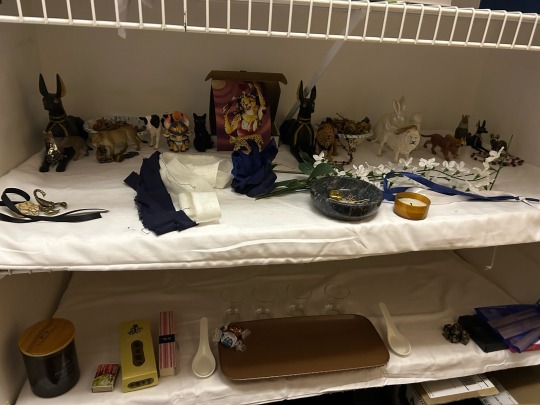
Due to limited space, my shrine is confined to a closet, but…
LOOKIT ALL THOSE GODS!!!!
From back left to right; Anubis, Sekhmet-Mut, Hathor-Nut, Bast, Mafdet, Wepwawet, Shezmu, (itty bitty) Amun-Ra, Nefertem, Wenut, Tefnut, Pakhet, Duamutef, and Anupet!
Front: Serqet!
Currently awaiting a proper statue for Amun-Ra, and need to get Mama Anupet a bigger jackal (I thought the itty bitty one was gonna be as big as Dad and Wep’s 😭) but!! It feels SOOO good to have Them all represented somehow!! 💜
Dua Netjeru!
Also please excuse the fuzz and ashes on the shrine cloth, I own a lot of black faux fur that sheds on everything, and ashes are kinda par for the course with incense smh
#anubis#sekhmet-mut#hathor-nut#bast#mafdet#wepwawet#shezmu#amun-ra#nefertem#wenut#tefnut#pakhet#duamutef#anupet#kemetic#kemeticism#kemetism#kemetic orthodox#kemetic orthodoxy#serqet
19 notes
·
View notes
Text
All dressed for the year
Wepwawet is all dressed up finally, it took me a few weeks to get the spoons to get to the craft store for the supplies I was missing. Colors for Nefertem's year are dark blue and white, some of the beads look black but they're actually blue, it's just the lighting.
I have a lot of statues -- a lot of Jackals -- and Wepwawet (with me) usually prefers to be in his full-jackal standing-on-all-fours pose, but this statue has been the exception. He wanted this statue quite a bit when I came across it.
It's a marble composite (cast marble to allow for detail, marble dust is mixed with something like resin and cast in a mold) on a solid marble base plate. The staff is made of metal. There are no hieroglyphs which is important to Him: He doesn't mind repurposing Anpu statues for Him, but He doesn't like when they come with glyphs, be them specific for Anpu or garbage glyphs. I do have Anpu statues repurposed that do have glyphs but He's generally given me a pass on those for various reason, be them much older (from my youth 20 years ago) or because He liked something about them.
The statue has such a beautiful, gentle expression, face, and ears. It is by far my favorite statue.
I have another icon I've always considered my "main" icon of Him (a wooden carving in standing jackal form) but He's actually gravitated more toward this one in recent years. I think the two icons represent two main, important aspects of Him (the full jackal form and the jackal-headed man form) so I guess He has two 'primary' icons for reasons all His own.
What Wepwawet wants, Wepwawet gets.


#wepwawet#upuaut#kemetic#kemeticism#polytheism#ancient egypt#god#gods#religion#spirituality#worship#ritual#kemetic orthodox
25 notes
·
View notes
Text
Accessibility in Kemetic Orthodoxy
While KO is pretty much all online there are a few things that arent.
Despite being a thing for a while now the temple has yet to fix its in accessible aspect. For example, to learn Fedw or go anywhere beyond Shemsu you must pay and travel.
This is incredibly inaccessible for disabled and poor people.
As a disabled person who is also very poor I could never learn Fedw despite very much wanting to.
This issue has been brought up but nothing fixed and it's incredibly frustrating.
I'd love to hear others thoughts but this really is a huge frustration of mine (and another huge reason I dropped down from Shemsu)
13 notes
·
View notes
Text

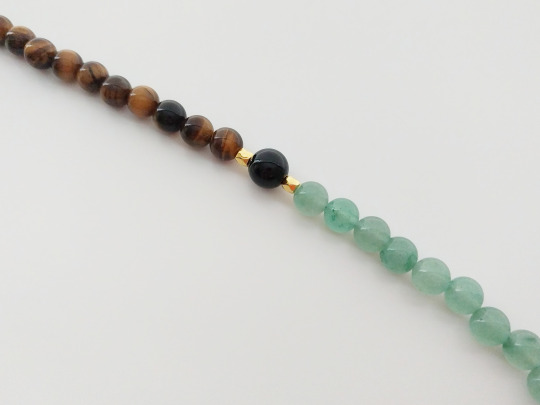

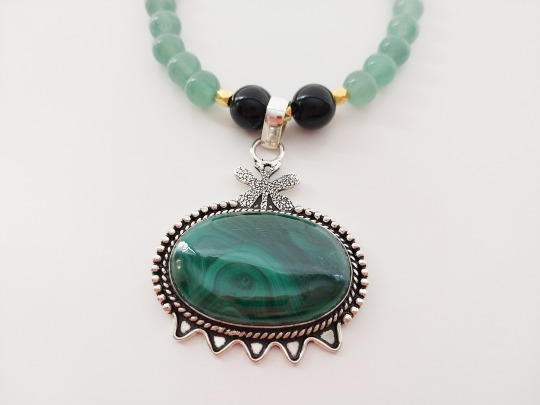
EGYPTIAN GODDESS BAST (BASTET) DEVOTIONAL NECKLACE
https://www.etsy.com/listing/1664211676/egyptian-goddess-bast-prayer-beads
Tiger's Eye and Green Aventurine gemstone beads, with a Silver and Malachite Pendant, Black Agate end pieces and accents, and a Gold-Colored Metal lobster clasp closure
Reblogging is welcome! <3
#Kemetic#Kemeticism#Bast#Bast*#Bastet#Goddess Bast#Deity Bast#Pagan#Kemetic Fandom#Kemetic Orthodox#Egyptian Goddess#Egyptian Gods#Egyptian Mythology#Egyptology#Ancient Egypt#Cat Goddess#Mother Goddess#Divine Feminine#Wicca#Wiccan#Witchcraft#Polytheist#Polytheism#Kemetic Prayer Beads#Pagan Prayer Beads#Devotional Beads#Devotional Jewelry#Sacred Jewelry#Pagan Jewelry#Kemetic Jewelry
4 notes
·
View notes
Text
So. I moved cities back in January and am about settled into my new place. Downside is that there isn’t much room for shrines (studio apartment) and I don’t have the shrine cabinet I used to use anymore. Been trying to think how I can go about this, especially as I really want to get back to doing regular Senut and Akhu rites. I still feel a bit uneasy about having temporary shrine setups (only bringing things out for rites and packing it away after) since it feels weirdly disrespectful, idk? I think it’s just a hangup on my end though. I think the main issue I’m still figuring out is having an actual nice surface to do this on because all the space I have is already taken up by other stuff lol
#🌟.txt#i’m also thinking about portable or mini shrines but idk how that would work#as the bowls and everything aren’t exactly portable#kemetic orthodox#kemetic
2 notes
·
View notes
Text

Ethics, morals and safety should be considered in all practices. Individuals will not always agree on how ethics should be incorporated, but listening to each other goes a long way. People will still disagree but taking the time to understand where the other party is coming from is part of strengthening the occult community.
Some faiths believe that what goes around, comes around, meaning that whatever you put out into the universe will revisit you. Some Pagan traditions believe that it comes back threefold as the universe's way of teaching people life lessons. Thus whatever good or harm that you put out into the universe "will come back to you in some way, shape, or form" because they see magick as an exchange of energies. HOWEVER, not every practitioner believes this ideology and that should be respected.
Everyone will have a difference of opinion.
Your ethics are up to you to decide.
Main areas of controversy:
• Consent: The reason baneful magick is considered so dangerous is because you don't have consent, Which means it can back fire onto you or just not work at all. This also can go towards positive spell work such as healing spells and love spells. The main reason a lot of people find issues with not having consent is free will. It is up to you to decide how you feel about consent in your magickal workings. As long as you take responsibility for what may come your way no one is allowed to look down on your practice.
• Using spirits or deity for your own gain: Let's put you in the spirits place. You have passed on and are still around for your family, friends, etc. People pull on your energy without asking you or offering you something in return. How, as the spirit being taken advantage of, do you feel? Do you think that the magick will work without energetically giving something in return to those that are having something taken from them? Probably not. Again, this is up to the practitioner to decide for themselves how they want to work with spirit, deity, and energy around them. But remember aome spirits were once in your shoes.
• White, Grey and Black Magick: These terms are used often but do we know where they originate from. In modern era these associate any magick that is performed by POC as black magick. That is just the typical thought process of someone not in the magick community. It is best we move away from these terms. I, Waric, tend to use positive, neutral and negative to describe my magick.
• Closed practices are those that you either must be born into or initiated into. Below.ia a list of some known closed practices:
• Voodoo
• Brujeria
• Buddhism (some paths ask a Buddhist before trying out a path, some are favorable to sharing, some are not)
• Catholicism
• Hindu
• Aztec
• Mayan
• Judaism
• Aboriginal Cultures (nearly all)
• Islam
• Orthodox Kemetism (worshiping a few Gods is okay and open though)
•Gardner Wicca (the most traditional version of it other branches are fine)
• Shinto
• Zoroastrianism
#discord#occultist#paganism#pagan#witch community#witches#witchblr#witchcraft#witch#occultism#magick#magickal#practitioner
23 notes
·
View notes
Text
I've resumed my work on "Literary Croatian", a fictional version of Standard Croatian invented for a project about a Croatia-led Yugoslavia (map's not mine, before you ask; but I vibe with the borders)
Prior to the mid-19th century, Croatian nationalists had a tendency to consider all the peoples we'd now recognise as Yugoslavs part of the Croatian natio - consider, for example, the ethographic work of Pavao Ritter. This isn't a peculiarity of Croatian ethnography per se; Serbian ethnography has (famously) traditionally considered the Serbian natio to include all South Slavs. Perhaps I should devote a separate post to the early development of Croat and Serb national movements... I digress - this timeline imagines, in essence, a successful 'Greater Croatia' in the proper sense: a Croatia incorporating all Serbo-Croatian lands, ruled from Zagreb. Perhaps Austria manages to annex Serbia during one of its endless wars with the Ottomans, or something; in any case, I quite like the idea of the Serbian Orthodox Church reconciling with the Holy See ITTL. Serbs as Byzantine rite Catholic Croats! Imagine!
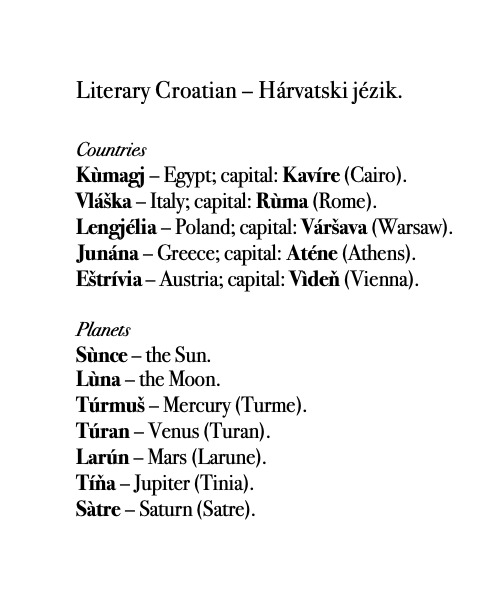
Unlike OTL Croatian, Literary Croatian represents the language's pitch accent system in writing - whence the acute and grave. The rest of the orthography is more-or-less faithful to OTL Croatian, if somewhat archaic (gj instead of đ for /dʑ/) and bohemicised (ň instead of nj for /ɲ/). The names themselves, however, have nothing to do with IRL Croatian:
Kùmagj is from /ˈku:mat/, the reconstructed Old Egyptian name for Egypt (whence "Kemet"). I love it so, so much. Kavíre is from Ottoman Turkish Kahire, w regular h>v/V_V
Vláška literally translates to "Wallachia" - vlah (from pGermanic *walhaz, the origin of "Walloon", "Cornwall", and "Wales") is the usual Slavic word for Romance-speaking peoples in general, particularly those of the Balkans. Compare Polish Włochy, "Italy"
Lengjélia is from Hungarian lengyel, "Pole", from pSlavic *lęděninъ, "Lendian; field-dweller".
Junána is another Turkish loanword, from Yunanistan. Literally no word for the Greeks more beautiful than derivatives of the Ionian name - fight me
Eštrivia is an irregular derivative of Bavarian Eestreu, "Austria". Vídeň is a direct borrowing from Czech; I prefer it over native Croatian Beč (from Hungarian Bécs).
Lúna is from pSlavic *luna. Though most Slavic languages have replaced their respective descendants of *luna with some variety of "measurer" (Croatian mjesec, Czech měsíc, from the same root as English "Moon"), the Literary Croatian word for the satellite reflects the original Slavic name - not cognate with Latin Luna, surprisingly enough!
All the other names are Etruscan. Using (latinised) Etruscan names for the planets is not a peculiarity of Literary Croatian, but rather a feature of all my alt-hist projects; it's just a bit of aesthetic furnish I like to add, like making Pisces the first sign of the Zodiac (like in the Voynich Manuscript) or moving New Year's back to March.
(Oh, and - the Literary Croatian word for England is Gremária; for America, Virgjínia.)
10 notes
·
View notes
Note
so like. how does it work practicing a religion that in part revolves around a river 12,000 km from you
For a moment I thought you meant the Ganghes and I wondered if you were conflating Hinduism with Buddhism because that's what nowadays forms the majority of my practice. But I think you mean me being Kemetic and the river you mean is the Nile.
Truth be told there is no consensus and to some extent the whole community is experimenting with it! Comes with the territory of reconstructing a religion from archaeological evidence.
As a bit of a case study why don't we take Wep Ronpet, Egyptian New Year. The theme of the holiday in antiquity was the beginning of the flood season which renewed the fertility of the Nile valley, equated to Zep Tepi, the primordial time of creation. Among modern Kemetics it has a meaning similar to the secular New Year: out with all the negativity and chaos of the year past, in with the new.
Opinions differ as to exactly when to celebrate Wep Ronpet. The event commemorated simply does not happen anymore. Since the construction of the Aswan Dam in 1960-1970 the Nile does not flood annually, so that cannot be the benchmark.
Some Kemetics mark it with a fixed date, usually around northern hemisphere summer to coincide with the ancient date. Agust 15th (September 11th in the Julian calendar) to coincide with the Coptic Orthodox Church's Feast of the Martyrs, the direct modern descendant holiday of Wep Ronpet still celebrated in Egypt, or July 18th for the date during the New Kingdom period.
Other Kemetics may celebrate it based on their own region's agricultural calendar. If I was doing it like this here in Guatemala I could perhaps do it around May or June which is the time of year when rainfall first spikes and the famous zompopos the mayo (a type of leafcutter ant that thrives in humidity, scientific name Atta cephalotes) begin to come out.
Finally, and most popularly, many kemetics base it around the date of the heliacal rising of sirius, a once-yearly astronomical event that used to coincide fairly close to the flooding of the Nile and was as such used in antiquity to estimate the date. Since the exact date of the heliacal rising varies depending on where on the globe you are opinions differ as to what to base the calculations off of. Members of The House of Netjer base it off their main temple in Illinois where former Nisut (pharaoh) Dr. Tamara L. Siuda resides. Others base it off the date in Egypt itself. And yet others base it off their own location.
I personally am partial to August 15th for entirely personal and practical reasons. I live in Guatemala City, August 15th is a public holiday because the patron saint of the city is The Virgin of the Assumption. So The Feast of the Assumption of the Holy Virgin Mary on August 15th, both a pan-Catholic holiday and specifically a local holiday I get a day off for is fitting I think. A very specific rejection and recontextualization of the religion I was raised with.
And that's what practicing a reconstructed religion comes down to, I believe. Weaving together the threads of history, archaeology, and anthropology to forge your own relationship with the cultural and spiritual practices that speak to you from these ancient cultures.
#kemetic#kemeticism#religion#by the way while I do not mind answering these at all#I'd much rather redirect them to my main (@aerial-jace) for when it does not intersect with WC or my fics kay?
9 notes
·
View notes
Text
psDntyw or Pesdjentiu; one moon, many names

originally posted on cohost and on my neocities!
I've returned to the subject of calendars once again with a new question. I am moving away from a solar calendar and the holidays of Pharaonic Egypt to a lunar calendar with personal, intuitive holidays. I'm sure this won't the the end of my relationship to the ancient calendar - but another journey of discovery that will culminate in a mix of both.
I started feeling out of sync with the Kemetic Orthodox calendar even before I left the House of Netjer*. It was a great tool to use in community with others, but in solitary practice it left me feeling untethered. It didn't connect to the land I live on; it rarely related to the day to day devotional practices I was developing. So I floated away, bobbing down the river to the sea.
The gods steered my ship across the Mediterranean: toward druidry, towards animism, towards Hellenism. I found things to learn - and still have things to learn - from these practices. Among them: a focus on the seasons here in Boston, along with re-tethering myself to the Moon. In 2020, my spirit work lead me to a relationship with a new entity. As a lunar spirit, she stirred the pot, urging me to be more mindful and open to change. Nothing stays the same, she reminded me, yet everything returns to where it began.
I have recently gotten to know a new group of Egyptian polytheists, many of whom are Egyptians themselves. Through their encouragement, I've started exploring how living Egyptians, regardless of their faith, engage in worship and mark their time. After all, my new peers remind me, Egyptian religion and polytheism did not end in the Pharaonic period.
The Islamic calendar (or Hijri) is a lunar calendar. Each month begins with the first observation of the waxing crescent (or Hilal). There is some debate on when precisely when the Hilal can be observed, though it is certainly after sunset.** Additionally, there is great debate over if one may use astronomical calculations to determine the presence of the new crescent or one must see it with their own two eyes. In the case of physical sightings, weather and geography can play a huge role in if the moon is visible at all on 29th day of a lunar cycle, resulting in different countries being on entirely different calendar dates than their neighbors!
Now what does that have to do with me, as a practitioner of Egyptian polytheism?
As someone seeking to reconnect my faith to the cycle of the moon and the seasons, I turned to what I know of the lunar calendar in the Pharaonic period. They too began their lunar months with the sighting of the first crescent; and in some places, this day was sacred to Ptah (see Dr. Siuda's The Ancient Egyptian Daybook). Now, these days I'm more of a Ptah-lytheist than a polytheist, but nothing feels more validating than seeing someone else's research point to what you're doing in neon signs saying "GO FOR IT"***.
Modern arguments on the topic of the sighting of the Hilal include asking if the process of looking for the moon is itself an act of worship. I take my cue from this argument. For myself, in adapting a modern practice to my ancient faith, observing the moon is absolutely an act of worship. It would be to have a convenient, set date like the new moon's zero percent visibility, or to even calculate when a single percentage of the crescent is theoretically visible. But it is much more in line with my animism, with my reverence of the place I live, with my desire to reconnect to the natural world, to take the time every night to step outside and admire the moon.
Tonight, I walked home from work and eagerly gazed the skies. Finally, after a few grey days, I spotted the crescent, rising just behind our local mosque. Happy first Pesdjentiu of 2024, Boston. May Ptah-Djehuty restore our light once again.
─── ⋅ ∙ ∘ ☽ ༓ ☾ ∘ ⋅ ⋅ ───
* I believe that Kemetic Orthodoxy / the House of Netjer is a cult. I witnessed so much emotional abuse and financial abuse in my ten years there. If you would like to discuss this privately, DM me. It is never too late to leave, no matter what they make you think.
** This is all very beyond my scope as a non-Muslim, but I would encourage interested parties to take the time to learn more on their own!
*** My relationship with Dr. Siuda is complicated (see note 1), but I won't deny she is an excellent source for information on both Pharaonic Egyptian religion as well as Coptic Christianity. I still use their Anglicization of psDntyw in English writing.
#kemetic polytheism#kemetic#kemetic fandom#kemetic pagan#kemetic paganism#kemeticism#egyptian paganism#egyptian polytheism#ptah#ptah-djehuty#lunar calendar#syncrectic paganism#moon worship#Pesdjentiu
7 notes
·
View notes
Text
Closed Practices
As one gets more into witchcraft, being aware of what religions and what practices are closed to you becomes more and more important, as does understanding why they are closed in the first place. Some are closed for reasons related to being oppressed, some are to protect those not initiated from bringing unintentional harm to themselves or others. regardless of the reason, they are closed and that status should always be respected.
Closed Practice- a practice that is only free for you to be a part of if you were born or initiated into. Most if not all of these practices belong to a religion or group of marginalized peoples
dreamcatchers, if you are to buy, buy directly from Indigenous peoples
Religious headwear or headwraps
Bindi- the mark or piece of jewelry worn in the middle of the forehead
Natha- a sub-tradition within Hinduism
Spiritual Symbols of Dharmic religion
Mudras- a type of ritual gesture or pose within Hinduism, Buddhism, and Jainism
Dreadlocs
Hoodoo
Sprulpa/tulpamancy- a practice specific to tibetan monks
Chakra- spiritual focus points of the body. These are NOT the same as energy points
Reiki- a type of spiritual healing that focuses around chakra
Closed Religion- a religion that requires an initiation process of some sort to join and practice their customs.
Judaism
Romani and other diasporic systems
Indigenous religions of any region, including but not limited to Polynesian, Americas, African, Caucasian, Mayan, Incan, Aztec, etc.
Sami
Hinduism
Sikh
Voodoo
Haitian Vodou
Rastafarian
Kemetic Orthodox
Serbian Polytheism
Santeria
Semiclosed religions- religions that have just a few traits of being closed but is otherwise open; religions that have an initiation process but their practices are not closed, religions that have certain practices that are closed, etc
Wicca (some branches are completely closed)
Buddhism (some branches/practices are completely closed)
Shinto
Chrisitanity/Catholicism and their branches
I'm sure there are still some missing or miscategorized, I'm not an expert as I try to avoid closed religions outside of those I may be interested in being initiated in. For those that I do know about or are commonly appropriated, there will be future posts about them specifically. Please contact me in some way if there are issues about the list so I can fix them as soon as possible! However, if you are looking to harass anyone or cause arguments, especially about a practice or religion you do not belong to, please find yourself somewhere else or you will be blocked! This blog is an informational resource, not a place to engage in debate.
Blessed Be and Have a good Summer Solstice! (a few days ago by this point, I know I'm posting late)
#adonissays#kirasays#grimoire of spica#digital grimoire#magick#witch lessons#beginner witch#witchcraft#buddhist pagan#buddhist#buddhist witch#pagan#closed religions#closed practices
26 notes
·
View notes
Note
You mentioned different types of Kemetic worship, from orthodox to eclectic pagan. Without any disrespect towards the reconstructionists. I am interested in the eclectic pagan flavour. Do the same resources work for me? I don't want to seem like I am doing "lesser"/"lazier" worship.
yep, the same resources that recons use would be useful for someone who wants to be more eclectic or loose in their practice. i personally like having historical information to play with, as it helps to give me a solid understanding of the mechanics within the religion/heka, and that makes it easier to create new things that are borne out of the original ideas while being new and different at the same time.
most kemetics i've come across are okay and supportive of doing things in new ways. the idea that you have to be 100% historically informed and structured is (thankfully) becoming a thing of the past - at least in the places i frequent. so i wouldn't be too worried about it.
*obvious caveats for instances of appropriation, etc.
13 notes
·
View notes
Text

FINALLY have a proper statue for Amun-Ra! (Featuring Shezmu and and Nefertem’s back peets)
14 notes
·
View notes
Text
The fires of change
I really burned myself down over the last month or two, and it's been therapeutic. The sheer amount of healing I've been able to do in a short amount of time that I wasn't able to do in (checks notes) four entire years. Hell I think I've been able to let go of things I suffered through 20 odd years ago as well.
Everything I've been through has been a necessity like no other, which sucks because I know along the way the impact to certain people around me has not been ideal. I've had to let bridges be burned and friendships go, but it was all part of that process, the burning to the ground in order to start again fresh (I'll try to avoid any phoenix references here as best I can).
Ok I lied: one phoenix.

At any rate, you'd be surprised how much healing your brain can do when you get to the point of enough-is-enough.
In the moment it feels as though you are making things two-hundred times worse, but to come out the other side with a version of mental health you didn't have when you went in, is a staggering, eye-opening process.
After this process, what I'm now feeling is a sense of an ability to reconnect back, but in a healthier way, to the things I thought I might never be able to connect with again. Because I've left the trauma I couldn't disconnect from behind, finally. I'm not saying it will ever be what it was again -- nor should it ever be -- but I'm finding myself re-engaging with a community I had felt was poisoned from the inside out, mostly because I've been watching the conversations unfolding in the face of extreme necessitated change, and they are... good, actually.
The conversations are good, the people are still good (well, most of them anyway), and the ideas people have for the future are also very, very good.
It's been awhile since I felt optimism about the Kemetic Orthodox side of my Kemetic faith. It's only one facet of my overall Kemetic life, but it's still one that has an importance to me I can't disregard.
I haven't seen nor heard from Tamara since I dropped down from Moderator. She made a post on the forums so people could ask her questions but has otherwise pretty much just been entirely absent from the community. It's interesting to see it from the perspective of a Remetj again, because from the Moderator perspective, we'd get to talk to Tamara with not-uncommon frequency -- sadly usually about bad things, but that would always evolve into conversations about good things as well.
This is my first time in a couple of years experiencing it from the other side of the community, and it's actually shocking the void of Tamara that's really out there. She made the right decision to step down, because she's really just not here anymore and hasn't been for awhile as I've already talked about before. And while she's willing to answer questions, she's still not actively engaged with the community the way I thought she might be. I'd imagine that's probably by design, but it's a design I disagree with. "The top" keeps assuring everyone not to worry that there are lots of discussions behind the scenes with Tamara, but that's the same-old same-old as always. That's not change.
In my personal opinion which means nothing, leaving the Nisut position behind should have resulted in Tamara's freedom to become a more active part of the community, not less. But despite this one thing which has not changed (and I never expected it to, not really), the conversations being had by the community are open, honest, and most importantly, they are happening. And right now I think I can't ask for more than that.
It's reconnected me to the community aspect, rather than the "Tamara" aspect, of Kemetic Orthodoxy. And I think that's what I've needed from the beginning. It's probably also what they wanted as well -- Tamara never wanted it to be about them alone. In fact, I remember once we had someone ask everyone: why were we Kemetic Orthodoxy? and I remember my answer:
It was for the community.
I think I'm finally starting to see it again, through the fog. But it's still not in focus, or clear.
3 notes
·
View notes
Text
Hey friends! Call me Syd! ❤
This is a sprinkling of my interests and things you might see here.

Base Stats: 37 y/o | Bi | Genderdoe | She/They | Beastpunk
Therianthropy: White-tailed Deer, Wyvern, Pallas Cat
Spirituality: Kemetic Orthodox Priest, Hedge Witch, Tarot Reader, Spirit Worker
Artistry: Furry, Devotional, Fantasy, Mythology, Creatures
Mediums: Digital, Watercolor, Marker
Daemon: Sencha - Mule Deer
Fandoms: Centaurworld, Furry, My Little Pony, Pokémon, FNAF, His Dark Materials, Ring Fit Adventure, Star Trek, Cats (Musical & Movie)

DNI: Please do not interact if you are "kin for fun" or identify as a "kinnie."
Other Blogs: Kemetic
Gallery:
Deer Therian Lines made by @/vixtvin.
Deer Therian Icon made by @/fl0atingtherians.
15 notes
·
View notes
Photo

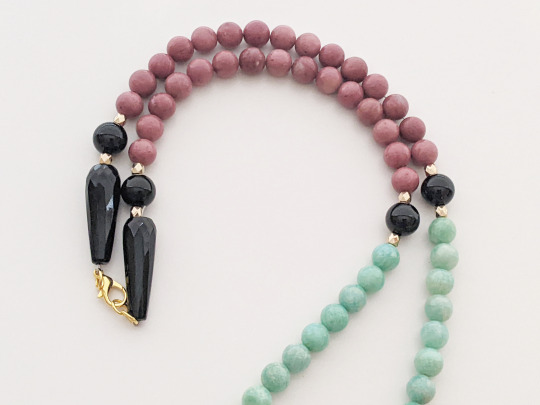

EGYPTIAN GODDESS TAWERET (THOERIS) DEVOTIONAL NECKLACE
https://www.etsy.com/listing/1426277631/egyptian-goddess-taweret-thoeris
Amazonite and Rhodonite gemstone beads with a Silver and Amazonite Pendant, faceted Black Agate end pieces and accents, and a Gold-Colored Metal lobster clasp closure
*Commissions are open!*
Reblogging is welcome! <3
#Kemetic#Pagan#Kemetic Fandom#Kemetic Orthodox#Kemeticism#Egyptian Gods#Egyptian Mythology#Egyptian Goddess#Egyptology#Ancient Egypt#Taweret#Thoeris#Tauret#Reret#Opet#Hippo Goddess#Mother Goddess#Fertility Goddess#Taweret Moon Knight#Divine Feminine#Wicca#Wiccan#Witchcraft#Kemetic Jewelry#Pagan Jewelry#Egyptian Jewelry#Kemetic Prayer Beads#Devotional Jewelry#Eye of Ra
25 notes
·
View notes
Text
Read Aset oracle here -> http://www.nisut.org/2022/07/aset-oracle-year-30.html?m=1
Deity of the Year: Heru-sa-Aset as Sema-Tawy , “Uniter of the Two Lands”
Colors of the Year: red and black (for the Two Lands of Kemet)
16 notes
·
View notes